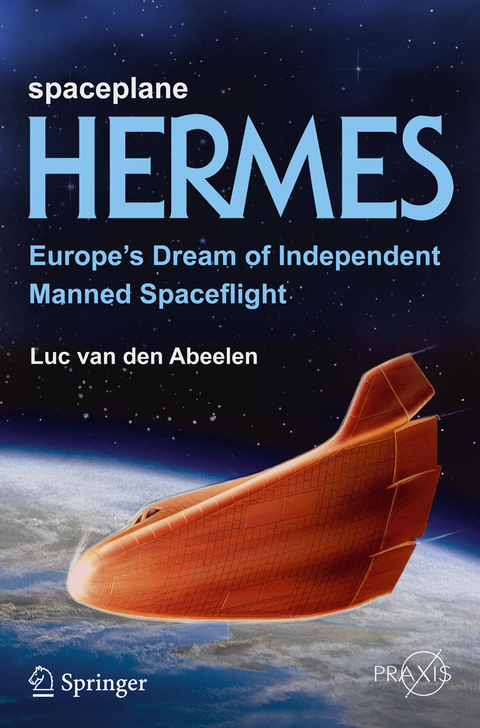
Spaceplane HERMES
Springer International Publishing (Verlag)
978-3-319-44470-3 (ISBN)
Luc van den Abeelen’s first publication was in Spaceflight magazine in 1987 on the subject of the Mir space station. He continued the Soviet/Russian theme of his writing and in 1999, wrote on the historical theme of the Soviet Lunar landing program, and, in the same year, in JBIS on the history of later planned Soviet Lunar mission. For the past 15 years, he has contributed commentary on current space events on national Dutch radio and television.
Origins: re-entry vehicles and orbital factories.- Getting serious: CNES develops a concept.- One or the other: selecting the prime contractor.- Safety rethink: the Challenger accident.- The road not taken: CNES decides against Maia.- The Hague: adoption by ESA.- Ever growing: Hermes gains a module.- Competition and the others: spacecraft from around the world.- Shifting priorities: equipment relocations (1989-1990).- The transatlantic scene: Freedom struggles, Columbus and the DoD.- Buying time: the six-month extension of Phase 1 (1990).- Outside influence: the costly fall of the Berlin Wall (1990-1991).- Change at Munich: stretching the imagination (1991).- Scaling down: X-2000 and Russia to the rescue (1991-1992).- Grenada: the end of the road (1992).- Descendants: of astronauts and wings.- Space freighter for ISS: the promise of ATV.- Hermes' legacy: a continued mission of sorts.- Keeping in touch: the DRS satellites and Mission Control.- Staying cool: the thermal protection system.- In Orbit Infrastructure: Platforms and Space Stations.- Learning to fly: astronauts and their training.- Inside and out: the space suits and escape systems.- Lift-off and getting home safely: preparation, launch and landing facilities.- Looking back: the Hermes experience.- Afterword.- Appendix A.- Appendix B.- Appendix C.
"Spaceplane HERMES is a very thorough book on the long history of the European quest to develop an independent human spaceflight capability. ... this reviewer views this book as an example of what works and what does not and how politics, diplomacy, funding, and technical challenges play into the development of complex international space systems. Overall, this book is appropriate for any individual with an interest in space history. Summing Up: Recommended. Lower- and upper-division undergraduates; professionals and general readers." (D. B. Spencer, Choice, Vol. 57 (11), July, 2017)
"A great book! A necessary book! ... For me the book in its chronological order and panoramic picture of all the managerial, technological, and political aspects of the Hermes project lets me fill in many gaps and leads to a better understanding of decisions which were not clear at all at the time. ... the book demonstrates the dream is alive and hopefully the next generation of politicians, managers and engineers will be educated by this 'historical' book." (Joachim J. Kehr, Journal of Space Operations & Communicator, opsjournal.org, Vol. 4 (1), January, 2017)"The book is written with an easy fl owing style which makes it suitable for all readerships. ... Arranged in chronological order, it opens in 1946 with France's fi rst tentative dreams of space. It is an attractively presented publication, well illustrated with diagrams and pictures. One must also not forget the extensive index." (Odyssey: The e-Magazine of the British Interplanetary Society, Issue 51, January, 2017)
| Erscheinungsdatum | 03.01.2017 |
|---|---|
| Reihe/Serie | Space Exploration | Springer Praxis Books |
| Zusatzinfo | XXII, 588 p. 187 illus., 97 illus. in color. |
| Verlagsort | Cham |
| Sprache | englisch |
| Maße | 155 x 235 mm |
| Themenwelt | Sachbuch/Ratgeber ► Natur / Technik ► Technik |
| Naturwissenschaften | |
| Technik ► Luft- / Raumfahrttechnik | |
| Schlagworte | Aerospace Technology and Astronautics • Ariane Rocket • Ariane V • Challenger Accident and Human Space Flight • CNES ESA • Columbus Module • Documenation of Space Project • European Spaceplane • European Space Shuttle • Extraterrestrial Physics, Space Sciences • HERMES Spaceplane Program • History of Science • Physics and Astronomy • Space taxi to ISS |
| ISBN-10 | 3-319-44470-0 / 3319444700 |
| ISBN-13 | 978-3-319-44470-3 / 9783319444703 |
| Zustand | Neuware |
| Haben Sie eine Frage zum Produkt? |
aus dem Bereich


